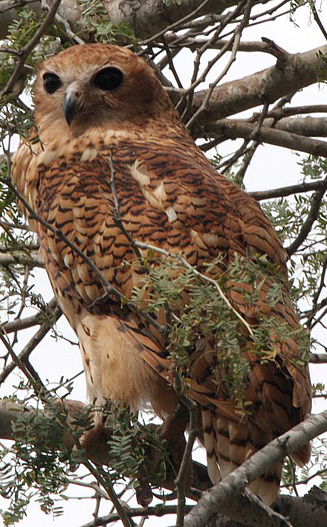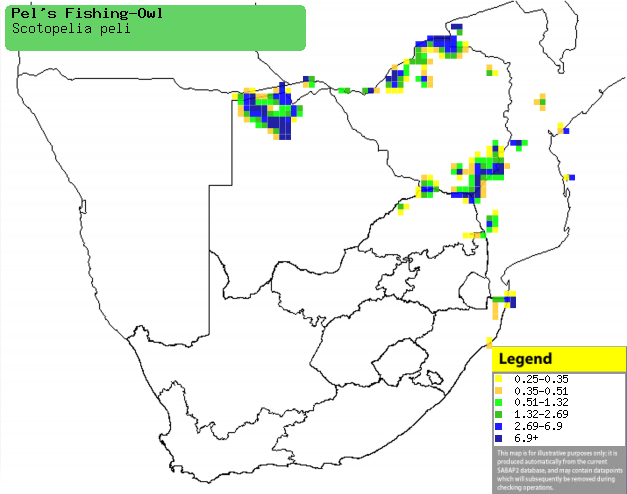|
Scotopelia peli (Pel's
fishing-owl)
Visuil [Afrikaans]; Dinidza [Shona]; Pel-visuil [Dutch];
Chouette-pÍcheuse de Pel [French]; Bindenfischeule, Fischeule [German];
Coruj„o-pesqueiro de Pel [Portuguese]
Life
> Eukaryotes >
Opisthokonta
> Metazoa (animals) >
Bilateria >
Deuterostomia > Chordata >
Craniata > Vertebrata (vertebrates) > Gnathostomata (jawed
vertebrates) > Teleostomi (teleost fish) > Osteichthyes (bony fish) > Class:
Sarcopterygii (lobe-finned
fish) > Stegocephalia (terrestrial
vertebrates) > Tetrapoda
(four-legged vertebrates) > Reptiliomorpha > Amniota >
Reptilia (reptiles) >
Romeriida > Diapsida > Archosauromorpha > Archosauria >
Dinosauria
(dinosaurs) > Saurischia > Theropoda (bipedal predatory dinosaurs) >
Coelurosauria > Maniraptora > Aves
(birds) >
Order: Strigiformes
> Family: Strigidae
 |
|
|
Pel's fishing-owl, Kruger National Park, South
Africa. [photo Trevor Hardaker
©] |
|
The Pel's fishing owl is restricted to areas surrounding
major river systems, such as the Zambezi River and the Okavango Delta. It is
generally localized and uncommon, preferring swamps or large tropical rivers
surrounded by riverine forest. It feeds almost exclusively on fish, catching
them with a similar style to the
African fish eagle, but it
also occasionally catches young Nile crocodiles! It usually nests in deep
cavities in riverine trees, less than 20 metres from the water's edge. Here it
lays 2 eggs, which are incubated solely by the female for 33-38 days. Of the two
chicks only one survives, the other obtains less food from its parents, and
usually dies of starvation after a few days. The surviving chick stays in the
nest for about 68-70 days, becoming fully independent a few months later.
Distribution and habitat
Restricted to areas surrounding
major river systems, occurring in patches of sub-Saharan Africa, although absent
from lowland forest. In southern Africa it occurs in the Caprivi Strip (Namibia),
northern Botswana, northern and southern Zimbabwe, Mozambique and eastern South
Africa. It generally prefers
swamps or large tropical rivers adjacent to riverine forest, but it may rarely
move into small pans, waterholes or narrow streams. It is generally localized
and uncommon, with an estimated 100 breeding pairs in the Okavango Delta.
|
 |
|
Distribution of Pel's fishing-owl in southern Africa,
based on statistical smoothing of the records from first SA Bird Atlas
Project (©
Animal Demography unit, University of
Cape Town; smoothing by Birgit Erni and Francesca Little). Colours range
from dark blue (most common) through to yellow (least common).
See here for the latest distribution
from the SABAP2. |
Predators and parasites
Food
It feeds almost exclusively on fish,
hunting by first surveying the surrounding water from a low perch. Once
it spots movement in an area of water, it rapidly dives with talons
outstretched, before returning to its perch to feed. It may also fly in low to
catch the fish without
submerging itself in water, in the manner similar to the
African fish eagle.
The following food items have been recorded in its diet:
- Vertebrates
- fish
- Clarias (catfish)
- Tilapia (bream)
- Hepsetus (pike)
- Synodontis (squeakers)
- reptiles
- amphibians
- Invertebrates
Breeding
- It usually nests in deep cavities in riverine trees, less than 20 metres
from the water's edge. It also uses old
Hamerkop nests, where it lays its eggs either on top of the nest or in part of the
collapsed roof structure.
- Egg-laying season is from January-June, peaking from February-April.
- It usually lays two eggs, which are incubated solely by the female for
33-38 days, while the male feeds her at the nest.
- Of the two chicks only one survives, as the other obtains less food from
its parents and usually dies of starvation after a few days. The surviving
chick stays in the nest for about 68-70 days, becoming fully independent a
few months later.
Threats
Globally not threatened, but Vulnerable in South
Africa, probably due to human disturbance and the pollution of rivers.
References
-
Hockey PAR, Dean WRJ and Ryan PG (eds) 2005. Roberts
- Birds of southern Africa, VIIth ed. The Trustees of the John Voelcker
Bird Book Fund, Cape Town.
|
